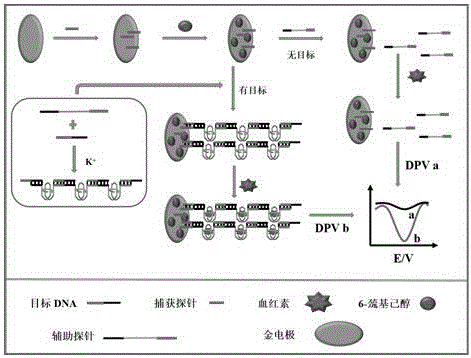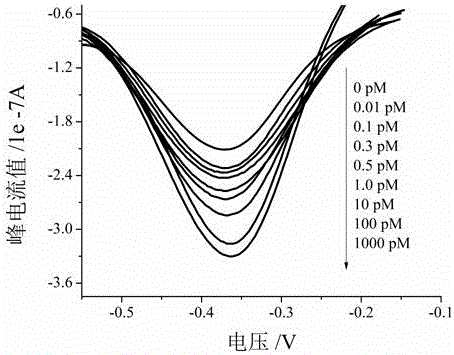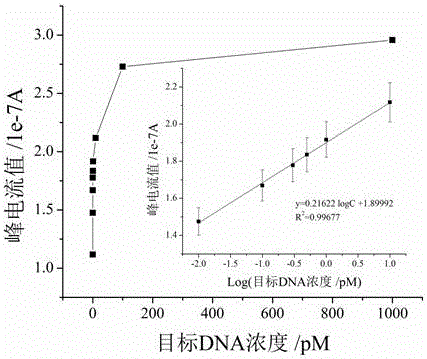Electrochemical method of detecting single-chain target DNA concentration based on G-quadruplex-heme compound and polymeric chain type amplification reaction
A polymer chain, heme technology, applied in the field of analytical chemistry, can solve the problems of radioactive contamination, low sensitivity, cumbersome operation, etc., and achieve the effect of high sensitivity detection, high sensitivity and strong specificity
- Summary
- Abstract
- Description
- Claims
- Application Information
AI Technical Summary
Problems solved by technology
Method used
Image
Examples
Embodiment 1
[0034] Example 1 Detection of HIV DNA concentration based on G-quadruplex-heme complex and polymerization chain amplification reaction.
[0035] Not all HIV gene carriers are suffering from AIDS. Mutations in this gene will lead to the destruction of the human immune system, thereby causing epidemics. It is of great significance for the early screening of AIDS to develop a sensitive detection method using the gene fragment where the mutation site is located as the detection target sequence.
[0036] The HIV gene fragment is used as the target DNA, and the detection steps are the same as those described above.
[0037] The target DNA sequence is: 5'- GGCAGCAATT TCACCAGTAC TA -3'.
[0038] The designed capture probe sequence is: 5'-HS-(CH 2 ) 6 - TTTAGTACTG GTG -3', the 5'-end of the probe is modified with a thiol group for self-assembly onto the gold electrode surface.
[0039] The designed auxiliary probe sequence is: 5'- AAATTGCTGC CTTT GGGTAG GGCGGGTTGG G CTTAGTACTGGTG...
Embodiment 2
[0047] Example 2 Specific Analysis of HIV DNA Detection
[0048] Taking the above HIV gene fragment as an example, the original target DNA was replaced with single-stranded DNA with single-base mismatch and triple-base mismatch to participate in the hybridization reaction, and the specific steps were the same as in Example 1.
[0049] The target DNA sequence is: 5'- GGCAGCAATT TCACCAGTAC TA -3'
[0050] The single base mismatch sequence is: 5'- GGCAGCAATT T G ACCAGTAC TA-3’
[0051] The three-base mismatch sequence is: 5'- GGCAGCAATT AGT CCAGTAC TA -3' (Mismatched bases are in italics)
[0052] Compare the signal response in the presence of target DNA, single-base mismatch DNA, and triple-base mismatch DNA in the presence of three different DNAs. Such as Figure 4 As shown, the single-base (B) and triple-base mismatches (C) produced much lower signal intensities compared to the signal increase produced by unmismatched target DNA (A), thus validating the constructed elect...
Embodiment 3
[0053] Example 3 Electrochemical DNA biosensor detects target HIV DNA in actual samples
[0054] Still targeting the above HIV gene fragments, a series of different concentrations of target HIV DNA were detected in the actual sample human serum, and the specific steps were the same as in Example 1.
[0055] Add a certain concentration of HIV DNA to human serum samples to obtain a series of serum samples with different concentrations of target DNA. After performing the reaction with the same operations and reagents as in steps (1)-(4), determine the conditions of target DNA at different concentrations. under the DPV graph (as Figure 5 shown). Analyze the relationship between the peak current value and the target DNA concentration in the DPV curve, and draw a linear fitting curve (such as Figure 6 shown). With the increase of the target DNA concentration, the oxidation peak current signal also increases. When the target DNA concentration is in the range of 10 fM to 10 pM, t...
PUM
 Login to View More
Login to View More Abstract
Description
Claims
Application Information
 Login to View More
Login to View More - R&D Engineer
- R&D Manager
- IP Professional
- Industry Leading Data Capabilities
- Powerful AI technology
- Patent DNA Extraction
Browse by: Latest US Patents, China's latest patents, Technical Efficacy Thesaurus, Application Domain, Technology Topic, Popular Technical Reports.
© 2024 PatSnap. All rights reserved.Legal|Privacy policy|Modern Slavery Act Transparency Statement|Sitemap|About US| Contact US: help@patsnap.com










